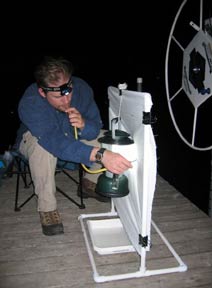Project Duration: 1 September 2004- 31 August 2005
Funding Source: National Science Foundation
The National Science Foundation administers a program for Long Term Ecological Research (LTER) to address ecological research over broad time scales (http://www.lternet.edu). Although highly successful, research in some areas is hindered by the sheer number of undescribed species and poorly known species in certain ecological settings. In aquatic ecosystems this is particularly the case with species of two-winged flies (Diptera) of the family Chironomidae that predominate in most habitats. Although represented in North America by approximately 1,300 described species, it has been estimated that 50% or fewer of the fauna for North America has been discovered and formally described. No detailed biodiversity assessments of Chironomidae have been made across a wide array of aquatic habitat types that occur at individual LTER sites.
LTER sites are selected based upon their representativeness of particular ecological settings and, with the exception of urban-based LTER sites, usually are among the most pristine areas available for research. Consequently, LTER sites can have a high incidence of undescribed species This project is a collaboration among Leonard Ferrington (Chironomidae Research Group, University of Minnesota), Martin Berg (Loyola University of Chicago) and Barbara Hayford (University of California, Davis) that focuses on evaluating the of biodiversity of Chironomidae at the North Temperate Lakes Long Term Ecological Research site (NTL LTER) in Wisconsin. Our preliminary research at the NTL LTER has already revealed 110 species of Chironomidae, including a significant number of undescribed species. Our goal is to collect and describe species from a wide array of aquatic habitats contained within the LTER and to document the basic conditions in which the species occur.
The scope of the project includes two field seasons and one winter. It is expected that at least 35-50 new species or life-stage associations will be discovered and described. In addition, specimens will be provided to colleagues presently describing species as part of other research projects and as many as 20-25 additional species will be described. Descriptions of these species will provide the taxonomic foundation for more detailed ecological research at the LTER.
Research products of this project are (1) species descriptions, (2) keys and illustrated guides for identification of adults, pupae and larvae, (3) collation of environmental data recorded with field collections, (5) electronically accessible data files searchable by species and habitat, and (6) home pages linked to the home pages of the NTL LTER. The keys will stimulate broader investigations of Chironomidae in aquatic ecology/pollution studies and facilitate better evaluations of Chironomidae in aquatic research at the LTER.
To be of use to non-research based regulatory agencies the results of this research must be widely disseminated. Consequently, other project products include development of electronic information products, including non-technical home pages, web-based keys and interactive data sets. Interactive keys will reside on the Internet, and standard keys for publication in journal format for adults and pupae will be completed. This research will provide benefits to local, state and federal agencies responsible for water quality management and/or environmental conservation by making data available through interactive, searchable data bases in formats useful for water quality managers and policy-makers at state and federal levels.







